�
Mining Text Data
�
Charu C. Aggarwal • ChengXiang Zhai
Editors
Mining Text Data
�
Library of Congress Control Number: 2012930923
Printed on acid-free paper Springer is part of Springer Science+Business Media (www.springer.com) All rights reserved. This work may not be translated or copied in whole or in part without the written permission of the publisher (Springer Science+Business Media, LLC, 233 Spring Street, New York, NY 10013, USA), except for brief excerpts in connection with reviews or scholarly analysis. Use inconnection with any form of information storage and retrieval, electronic adaptation, computer software,or by similar or dissimilar methodology now known or hereafter developed is forbidden.The use in this publication of trade names, trademarks, service marks, and similar terms, even if theyare not identified as such, is not to be taken as an expression of opinion as to whether or not they aresubject to proprietary rights. Springer New York Dordrecht Heidelberg LondonISBN978-1-4614-3222-7e-ISBN978-1-4614-3223-4DOI10.1007/978-1-4614-© Springer Science+Business Media, LLC 2012EditorsCharu C. AggarwalIBM T.J. Watson Research CenterYorktown Heights, NY, USAcharu@us.ibm.comUniversity of Illinois at Urbana-ChampaignUrbana, IL, USAczhai@cs.uiuc.edu3223-4ChengXiang Zhai�
Contents1AnIntroductiontoTextMining1CharuC.AggarwalandChengXiangZhai1.Introduction12.AlgorithmsforTextMining43.FutureDirections8References102InformationExtractionfromText11JingJiang1.Introduction112.NamedEntityRecognition152.1Rule-basedApproach162.2StatisticalLearningApproach173.RelationExtraction223.1Feature-basedClassification233.2KernelMethods263.3WeaklySupervisedLearningMethods294.UnsupervisedInformationExtraction304.1RelationDiscoveryandTemplateInduction314.2OpenInformationExtraction325.Evaluation336.ConclusionsandSummary34References353ASurveyofTextSummarizationTechniques43AniNenkovaandKathleenMcKeown1.HowdoExtractiveSummarizersWork?442.TopicRepresentationApproaches462.1TopicWords462.2Frequency-drivenApproaches482.3LatentSemanticAnalysis522.4BayesianTopicModels532.5SentenceClusteringandDomain-dependentTopics553.InfluenceofContext563.1WebSummarization573.2SummarizationofScientificArticles58v�
for Summarization
2.
Feature Selection and Transformation Methods for Text
Clustering
81
5
Dimensionality Reduction and Topic Modeling
Steven P. Crain, Ke Zhou, Shuang-Hong Yang and Hongyuan Zha
1.
2.
3.
4.
Introduction
1.1
The Relationship Between Clustering, Dimension
Reduction and Topic Modeling
Notation and Concepts
The Procedure of Latent Semantic Indexing
Implementation Issues
Analysis
1.2
Latent Semantic Indexing
2.1
2.2
2.3
Topic Models and Dimension Reduction
3.1
3.2
Interpretation and Evaluation
Probabilistic Latent Semantic Indexing
Latent Dirichlet Allocation
129
130
131
132
133
134
135
137
139
140
142
148
viMININGTEXTDATA3.3Query-focusedSummarization583.4EmailSummarization594.IndicatorRepresentationsandMachineLearning4.1GraphMethodsforSentenceImportance604.2MachineLearningforSummarization625.SelectingSummarySentences645.1GreedyApproaches:MaximalMarginalRelevance645.2GlobalSummarySelection656.Conclusion66References664ASurveyofTextClusteringAlgorithms77CharuC.AggarwalandChengXiangZhai1.Introduction772.1FeatureSelectionMethods812.2LSI-basedMethods842.3Non-negativeMatrixFactorization863.Distance-basedClusteringAlgorithms893.1AgglomerativeandHierarchicalClusteringAlgorithms903.2Distance-basedPartitioningAlgorithms923.3AHybridApproach:TheScatter-GatherMethod944.WordandPhrase-basedClustering994.1ClusteringwithFrequentWordPatterns1004.2LeveragingWordClustersforDocumentClusters1024.3Co-clusteringWordsandDocuments1034.4ClusteringwithFrequentPhrases1055.ProbabilisticDocumentClusteringandTopicModels1076.OnlineClusteringwithTextStreams1107.ClusteringTextinNetworks1158.Semi-SupervisedClustering1189.ConclusionsandSummary120References12160�
Contentsvii4.1Interpretation1484.2Evaluation1494.3ParameterSelection1504.4DimensionReduction1505.BeyondLatentDirichletAllocation1515.1Scalability1515.2DynamicData1515.3NetworkedData1525.4AdaptingTopicModelstoApplications1546.Conclusion155References1566ASurveyofTextClassificationAlgorithms163CharuC.AggarwalandChengXiangZhai1.Introduction1632.FeatureSelectionforTextClassification1672.1GiniIndex1682.2InformationGain1692.3MutualInformation1692.4χ2-Statistic1702.5FeatureTransformationMethods:SupervisedLSI1712.6SupervisedClusteringforDimensionalityReduction1722.7LinearDiscriminantAnalysis1732.8GeneralizedSingularValueDecomposition1752.9InteractionofFeatureSelectionwithClassification1753.DecisionTreeClassifiers1764.Rule-basedClassifiers1785.ProbabilisticandNaiveBayesClassifiers1815.1BernoulliMultivariateModel1835.2MultinomialDistribution1885.3MixtureModelingforTextClassification1906.LinearClassifiers1936.1SVMClassifiers1946.2Regression-BasedClassifiers1966.3NeuralNetworkClassifiers1976.4SomeObservationsaboutLinearClassifiers1997.Proximity-basedClassifiers2008.ClassificationofLinkedandWebData2039.Meta-AlgorithmsforTextClassification2099.1ClassifierEnsembleLearning2099.2DataCenteredMethods:BoostingandBagging2109.3OptimizingSpecificMeasuresofAccuracy21110.ConclusionsandSummary213References2137TransferLearningforTextMining223WeikePan,ErhengZhongandQiangYang1.Introduction2242.TransferLearninginTextClassification2252.1CrossDomainTextClassification225�
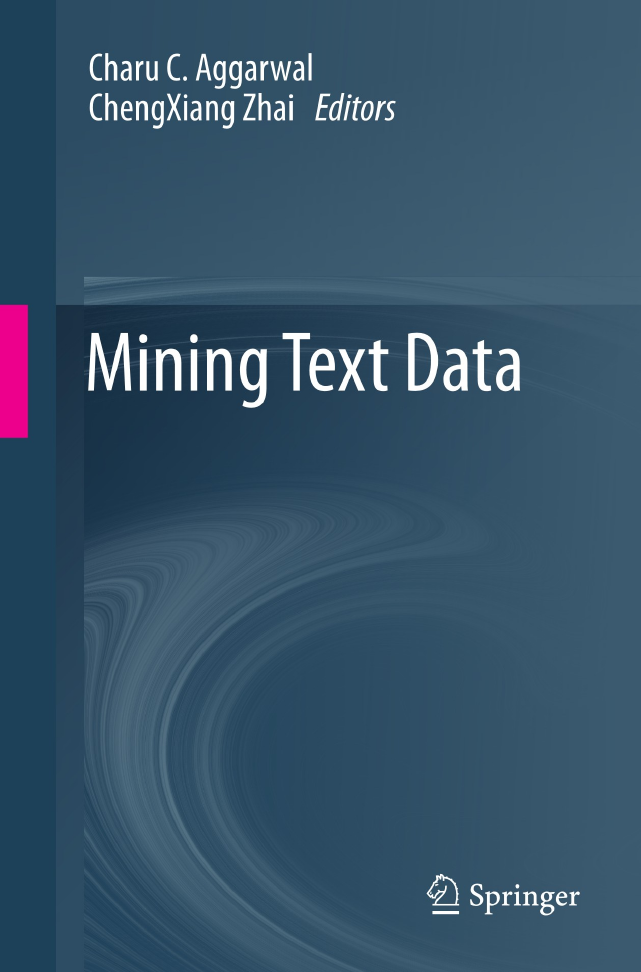
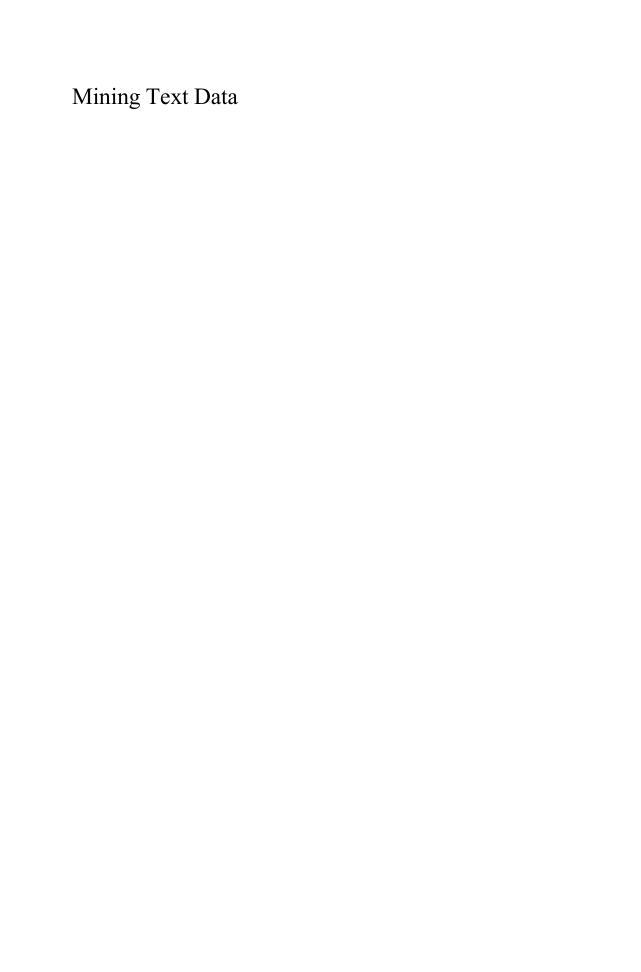

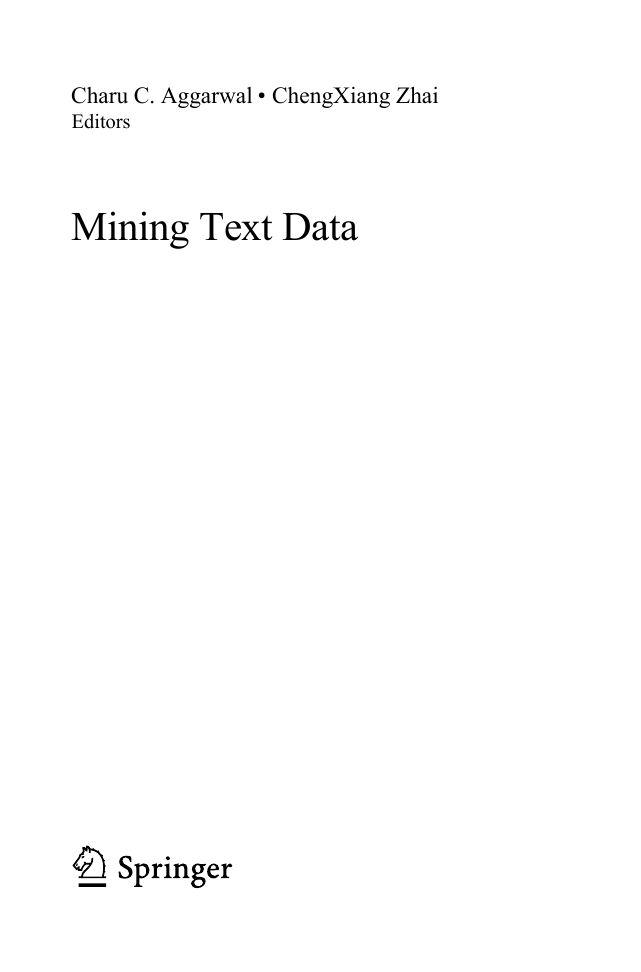
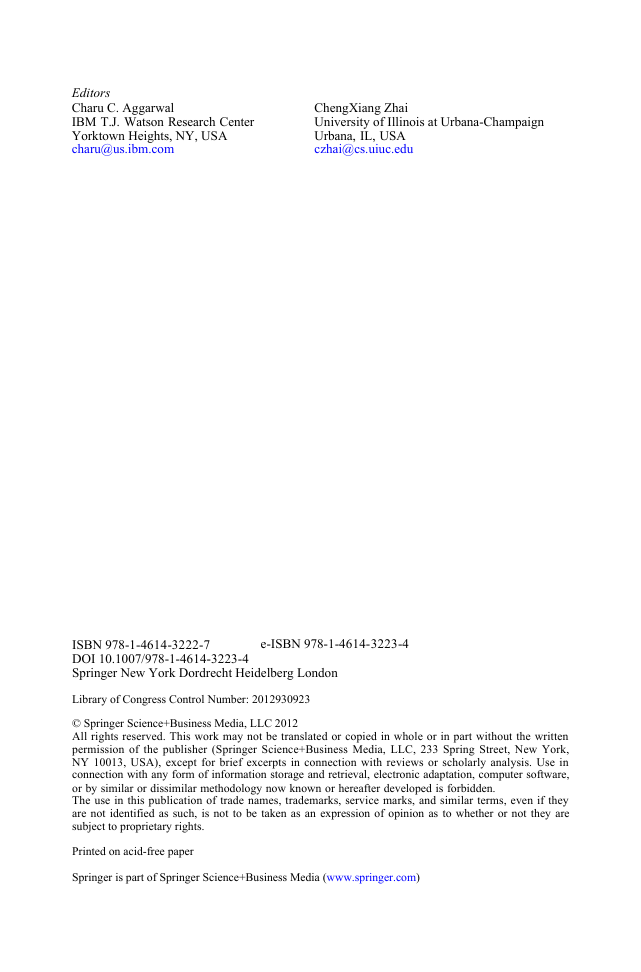
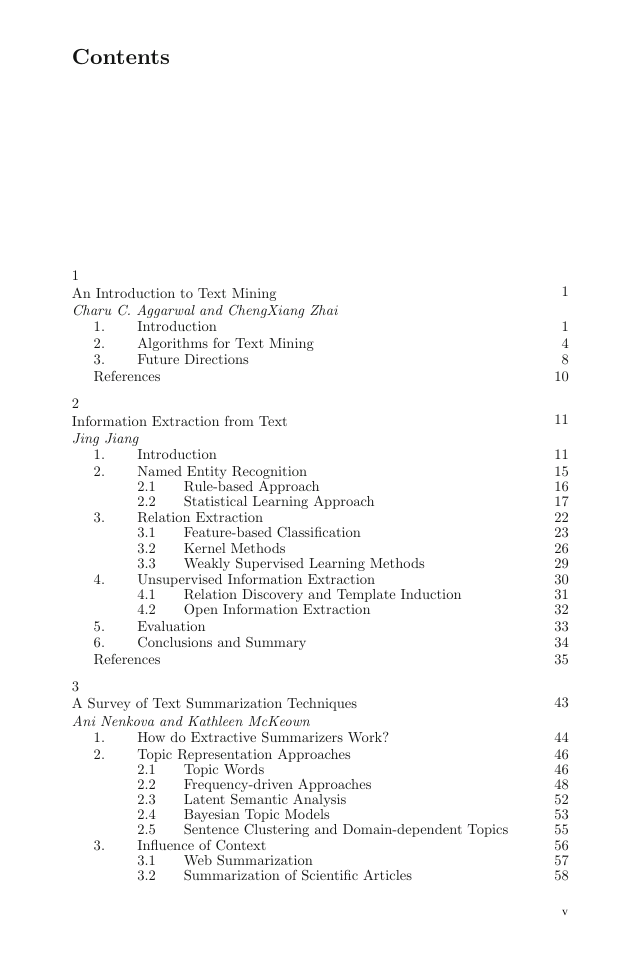
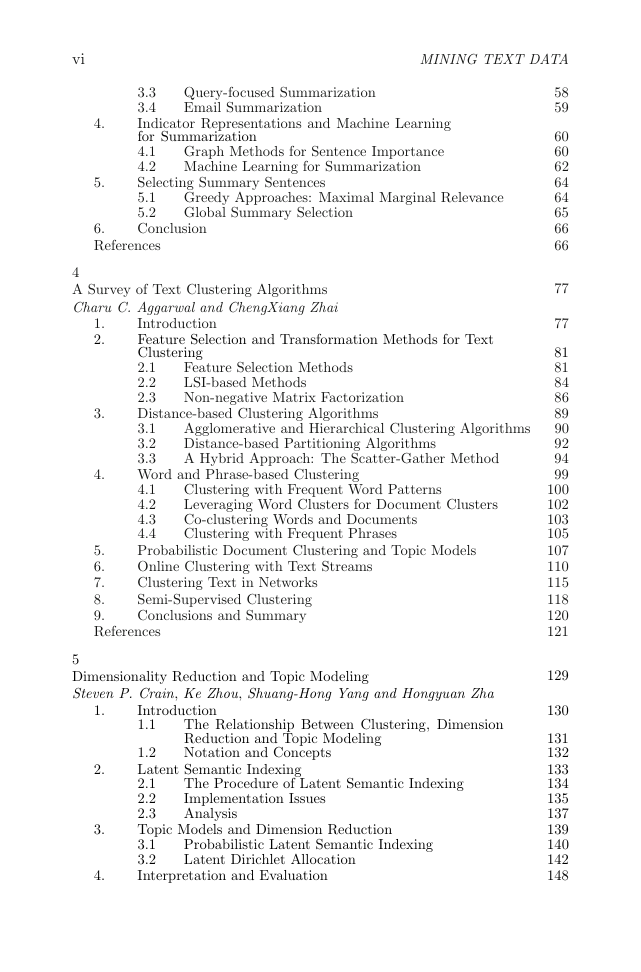
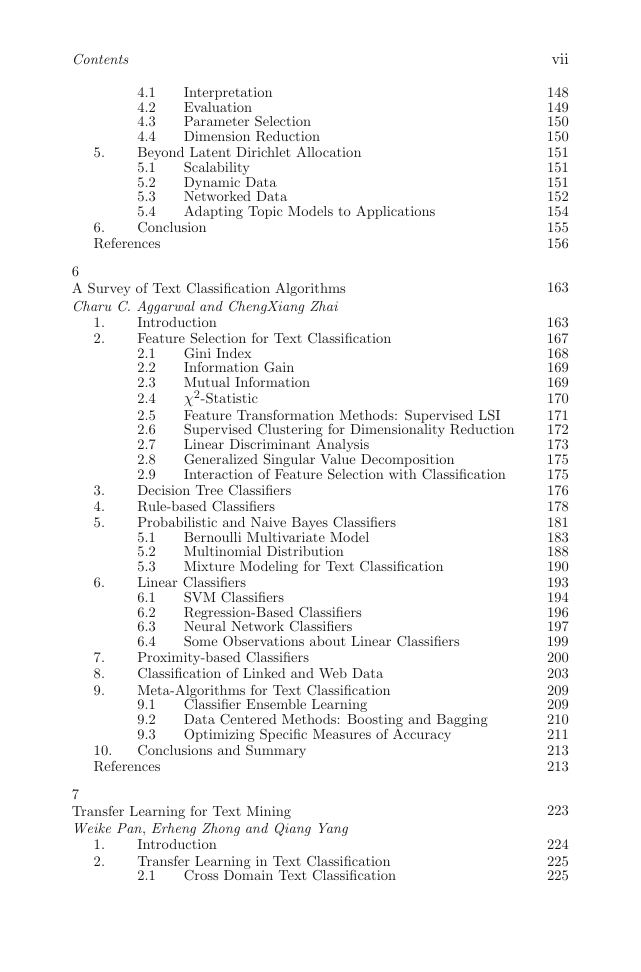








 2023年江西萍乡中考道德与法治真题及答案.doc
2023年江西萍乡中考道德与法治真题及答案.doc 2012年重庆南川中考生物真题及答案.doc
2012年重庆南川中考生物真题及答案.doc 2013年江西师范大学地理学综合及文艺理论基础考研真题.doc
2013年江西师范大学地理学综合及文艺理论基础考研真题.doc 2020年四川甘孜小升初语文真题及答案I卷.doc
2020年四川甘孜小升初语文真题及答案I卷.doc 2020年注册岩土工程师专业基础考试真题及答案.doc
2020年注册岩土工程师专业基础考试真题及答案.doc 2023-2024学年福建省厦门市九年级上学期数学月考试题及答案.doc
2023-2024学年福建省厦门市九年级上学期数学月考试题及答案.doc 2021-2022学年辽宁省沈阳市大东区九年级上学期语文期末试题及答案.doc
2021-2022学年辽宁省沈阳市大东区九年级上学期语文期末试题及答案.doc 2022-2023学年北京东城区初三第一学期物理期末试卷及答案.doc
2022-2023学年北京东城区初三第一学期物理期末试卷及答案.doc 2018上半年江西教师资格初中地理学科知识与教学能力真题及答案.doc
2018上半年江西教师资格初中地理学科知识与教学能力真题及答案.doc 2012年河北国家公务员申论考试真题及答案-省级.doc
2012年河北国家公务员申论考试真题及答案-省级.doc 2020-2021学年江苏省扬州市江都区邵樊片九年级上学期数学第一次质量检测试题及答案.doc
2020-2021学年江苏省扬州市江都区邵樊片九年级上学期数学第一次质量检测试题及答案.doc 2022下半年黑龙江教师资格证中学综合素质真题及答案.doc
2022下半年黑龙江教师资格证中学综合素质真题及答案.doc